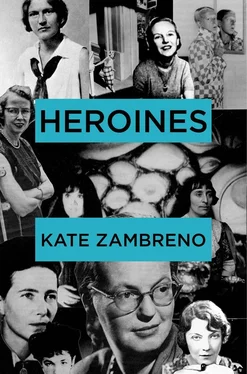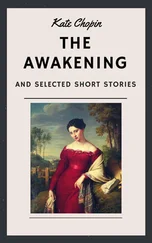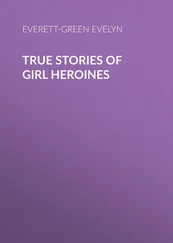Before (and after) the talking cure, a whole range of treatments and types of doctors were thrown at these nervous women. A series of specialists and experimental routines. Pseudo-science and magic men and witch doctors. The gland specialist. The one who kept Viv on a diet of fruit and water. One particular Bloomsbury quack whose injections turned out to be nothing but milk. A Spartan diet, special exercises, enemas for constipation. She was told to stand daily on her head.
Compose yourself. Compose yourself. They are supposed to hold it in. To not act out. Dear, one must not create a scene. The discipline and containment of diagnosis. A diagnostic label becomes a sort of straitjacket — one learns to self-discipline, to watch over oneself for signs of dis-ease, and any symptoms are read through this filter (energy is suspect, excitability is to be dulled down, how did they get up the nerve to do anything, let alone write?).
She is simultaneously pathologized and dismissed. You are sick. You are acting hysterical. There’s nothing wrong with you. It’s all in your head. Romance novel readers call this “wallpapering,” after the story.
The narrator in “The Yellow Wallpaper” notes that she takes pains to control herself and controlling herself makes her feel even more fatigued. Gilman’s doctor was the famous Dr. Silas Weir Mitchell whose grand idea was the “rest cure,” and the story is a parody of the effects of such a cure.
Silas Weir Mitchell, the neurologist who once opined, “The man who does not know sick woman does not know woman.” A continuance of a deep-bred ideology since antiquity that women were mad by their very nature (primitive, emotional, weak, hysteria coming from the Greek hystera for womb).
Mitchell’s whole idea was that women got sick because they were trying to be like men when really they should be kept in an infantile state. So neurasthenics were sent to a nursing home, expected not to stir, to sleep abundantly, to drink great quanties of milk and red meat for weight gain, and to avoid any stimulation or excitement. Women were pushed into the feminine role (housewife, mother), men into the masculine one (being a good father and provider, picking up sports), because of this belief that illness came from deviating from one’s natural sex role. They were all prescribed sedatives as well.
Woolf was often sent to these nursing homes, which she found unbearable and usually exacerbated her depression.
In 1970, at a meeting before the American Psychological Association, a mostly male audience of psychologists, feminist psychologist Phyllis Chesler asked for one million dollars in reparations for women who had been “punitively labeled, overly tranquilized, sexually seduced while in treatment, hospitalized against their wills, given shock therapy, lobotomized, and above all, unnecessarily described as too aggressive, promiscuous, depressed, ugly, old, fat, or incurable.” The audience sat there in silence. Maybe they thought it was a joke.
Could it be anxiety? In Chicago, soon after returning from London I began seeing a French doctor. Dr. Bruno. I chose him solely because he is French. It made it easier to select a doctor from the enormous hmo list provided by the insurance company. I thought a French doctor would be more willing to see me, somehow.
I was obviously wrong.
Dr. Bruno is short and stubby. I tell him “I am a writer.” (Must stop telling people this). “I write too,” he says.
Everyone is working on a novel. My doctor is working on a novel, a fellow adjunct, a silver-haired art historian, is working on a novel. About a silver-haired art historian/spy.
Could it be anxiety? my French doctor muses in his French way. I call him this week to complain of fatigue, swollen glands.
I don’t know. It could be, I say. I am desperate. It has been well-documented that women are diagnosed more because they are trained to be help-seekers. SOS. Save me from myself.
He prescribes Xanax. Little peach pills.
“My nerves are bad tonight. Yes, bad.” Diagnosed with nerves, with old-fashioned neurasthenia. A recent headline, trumpeting from the science page of The New York Times : “Is Hysteria Real? Brain Images Say Yes.” Good to know.
Should I be worried about side effects? He waves his hand, disparagingly.
(After weeks on the benzos, I wean myself off, and the withdrawal is terrible, the shakes, the paranoia, the panic attacks.)
Vivien(ne) was 16 when her mother turned to the family doctor to control her. Doses of bromides for “hysterics.” Hoffman’s anodyne, dissolved in ether. Her breath always stank of it. A vampiric vibe. Along with the white makeup to cover up the spots caused by the bromides.
“And so the process of tranquillising Vivienne began.”
For Viv and Zelda: chloral hydrate ovarian extracts dried thyroid gland powders
Zelda was injected with her own blood and a “serum made from the blood of a mentally stable person.”
Also: belladonna luminal morphine stromium digitalis
hydrotherapy:
purges
wet packs
insulin therapy (used for female patients, “realigned behavior”)
ECT
coma therapy
Virginia: teeth pulling veronal adalin chloral hydrate paraldehyde potassium bromide digitalis
Dr. Bruno relaxes. He leans back in his chair. “Tell me, do you enjoy the novels of Julian Barnes?”
I find myself cycling through them. A form of possession.
The Vivien(ne) possession is a bit like being Linda Blair in The Exorcist .
I act like a demon woman. The dybbuk , a doubling.
She would grow violent at the stone walls he erected, her Lloyd’s of London banker. He becomes the Great Debater. The Eternal Skeptic. What are we fighting about? Usually about my need to escape. To get out of here (wherever here is at the present time). To some mythical New York, most likely.
The moment I grow violent, in any way — slapping him on the shoulder, throwing a book, throwing my phone, telling him to FUCK OFF — he has won and I have lost. Because now he can point to the violent me as the monstrous thing.
What do I lose? I lose myself.
(I hate that there is this role, the mad wife. And I hate when I play it.)
A definition, I think, of being oppressed, is being forbidden to externalize any anger.
I am beginning to realize that the patriarch decides on the form of communication. Decides on the language. The patriarch is the one who rewrites.
How did you inherit such violence? he asks. He is laughing. It is the way he unconsciously defends himself from conflict. When I exhibit intense emotion.
“The Sibyl, with frenzied mouth uttering things not to be laughed at, unadorned and unperfumed, yet reaches to a thousand years with her voice by aid of the god.”
It is this laughter that destroys me. “John laughs at me, of course, but one expects that in marriage,” writes the narrator in “The Yellow Wallpaper.”
But he is violent too. “In masculine hands logic is often a form of violence, a sly kind of tyranny,” writes Simone de Beauvoir. He tears me into rags and rages.
The Eliots’ violent fights in public. She liked to humiliate him in front of strangers. In one of Vivien(ne)’s stories her heroine Sibylla throws parcels down the stairs. “She hits Andre on the face with her umbrella. Having done it once she does it again. The whole world totters — it spins about her. She longs to destroy herself and looks wildly about but there is no window low enough from which to cast herself, no knife or weapon presents itself for her purpose.”
The hysteria of the marital fight — grabbing for any convenient weapon to use against oneself or against each other.
In one manuever I pantomine suicide — opening the window and making motions to climb out until John grabs me, embarrassed people might be watching. We are only on the second floor, he reminds me.
Читать дальше












